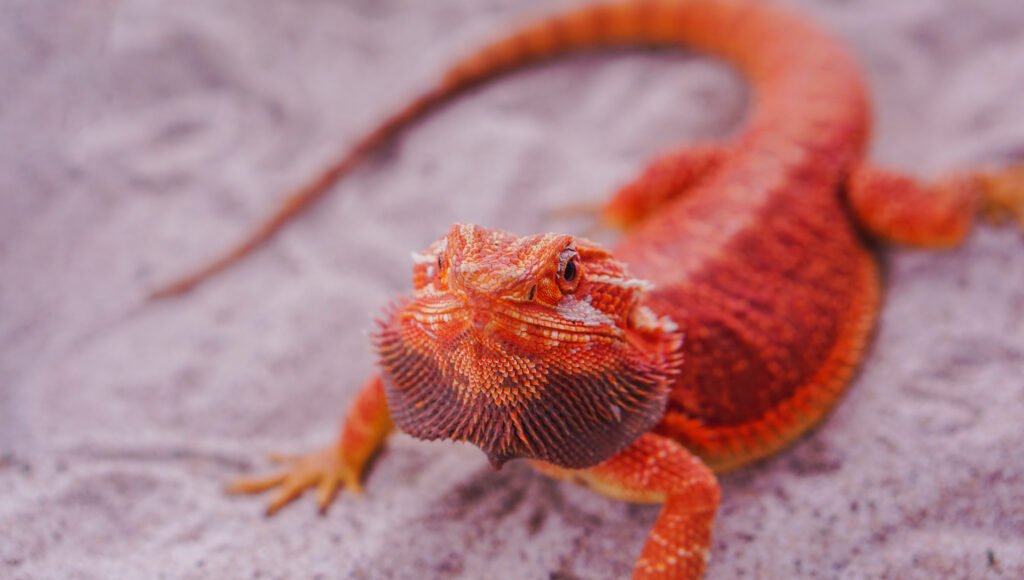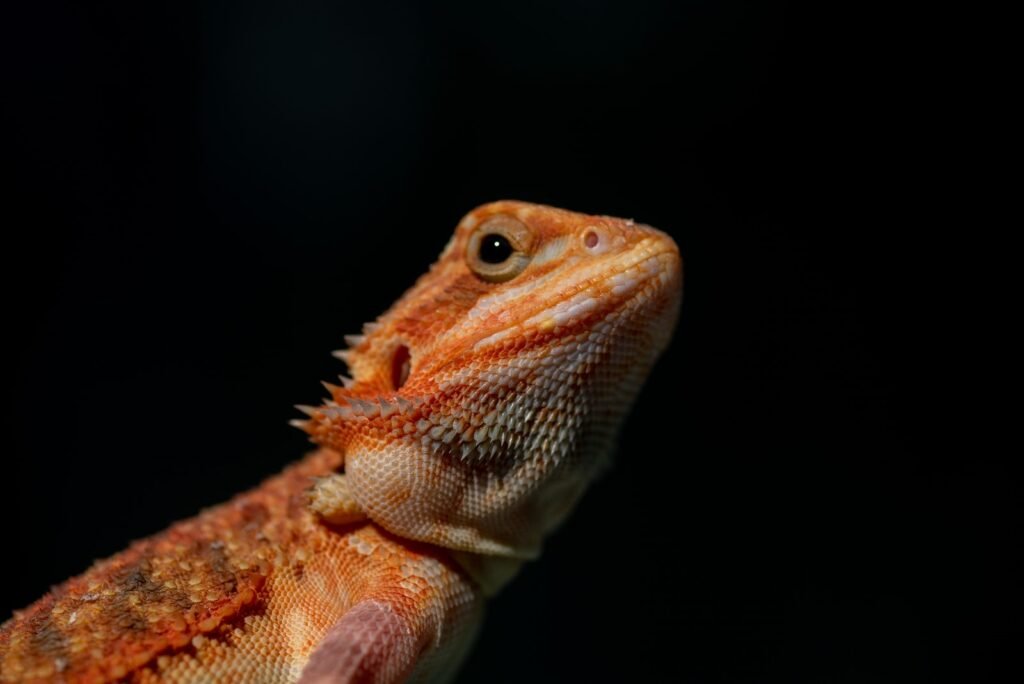Discover the fascinating world of bearded dragon behavior and enrichment with our comprehensive guide. Learn how to interpret common behaviors such as arm waving and head bobbing, and gain insights into signs of stress and contentment.
Explore advanced enrichment strategies to stimulate your pet’s mind and body, from structured routines to interactive play and mental stimulation. Whether you’re a new owner or a seasoned enthusiast, unlock the secrets to enhancing your bearded dragon’s quality of life with expert tips and techniques.
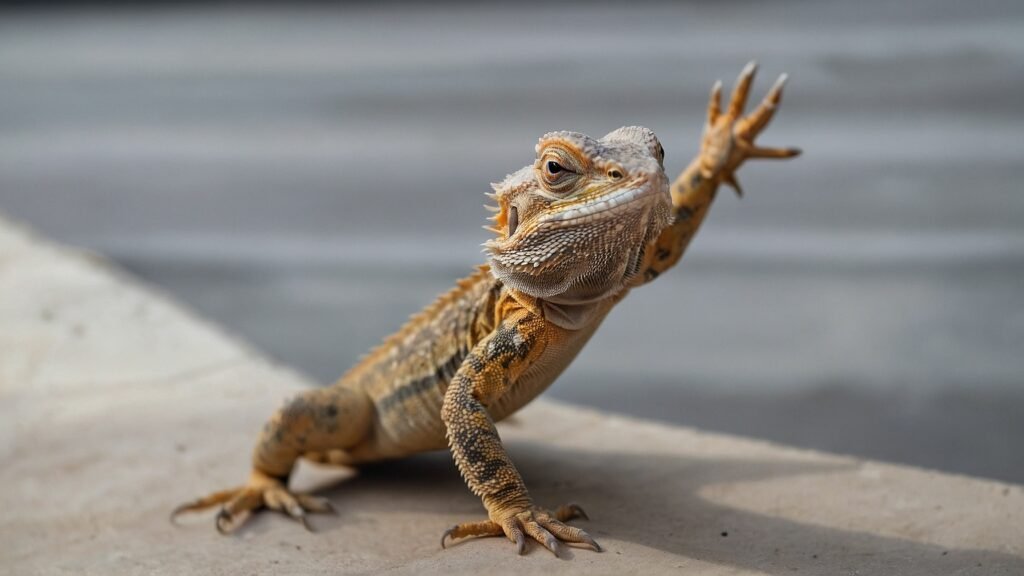
- Understanding Bearded Dragon Behavior
- Environmental Enrichment for Bearded Dragons
- Physical Enrichment for Bearded Dragons
- Mental and Sensory Enrichment for Bearded Dragons
- Music and Auditory Stimuli
- Visual Stimulation through Colors and Movement
- Interactive Play and Handling for Bearded Dragons
- Feeding as Enrichment for Bearded Dragons
- Health and Enrichment for Bearded Dragons
- Enrichment Outside the Terrarium
- Creating a Routine for Enrichment
- Advanced Enrichment Strategies for Bearded Dragons
Understanding Bearded Dragon Behavior
Bearded dragons are fascinating reptiles with a range of behaviors that can tell you a lot about their mood and health. Observing and understanding these behaviors can help you provide a better environment for your pet.
Interpreting Common Behaviors
🔸Arm Waving: This quirky action may seem like your bearded dragon is trying to say hello, but it’s actually a sign of submission. It’s often seen in younger dragons when they are acknowledging a more dominant dragon or sometimes, to show humans they recognize their presence.
🔸Head Bobbing: Faster head bobs can be an assertion of dominance, often seen in males during mating season. Slower bobs might be a friendly acknowledgement. If your dragon rapidly bobs its head at you, it’s likely they are trying to show who’s boss.
🔸Beard Fluffing: When a bearded dragon puffs out its beard, it may be trying to look more intimidating. This could be due to feeling threatened or trying to impress a potential mate.
Signs of Stress and Contentment
Stress can be harmful to bearded dragons, so it’s vital to recognize the signs. Stress marks, which are dark lines or patches on the dragon’s belly, are a clear indication. If your dragon is trying to escape its tank frequently, it may also be stressed. On the other hand, a content dragon will have bright, clear eyes and will be active and alert. They’ll also show a healthy appetite and have a regular sleeping pattern.
Social Behaviors with Other Bearded Dragons and Animals
Bearded dragons are typically solitary creatures. While they can coexist with others, they need enough space to establish their own territories. Watch for signs of aggression if they are housed together and provide separate basking spots to reduce tension. When it comes to other animals, bearded dragons might view smaller creatures as prey and larger animals as predators. Always supervise interactions with other pets to ensure safety for all.
By paying close attention to these behaviors and signs, you can ensure your bearded dragon is not only physically healthy but also happy and stress-free. Remember, each dragon is unique, and learning to read your specific pet’s signals is part of the joy of keeping these charismatic reptiles.
Environmental Enrichment for Bearded Dragons
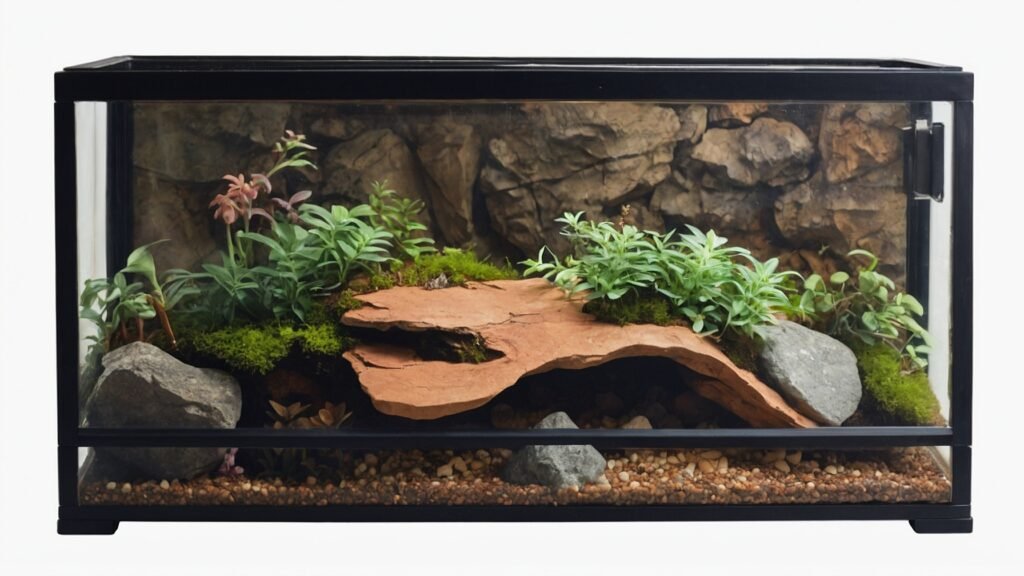
Creating an engaging environment for a bearded dragon is not just about aesthetics; it’s crucial for their health and happiness. Here’s how you can make your scaly friend’s habitat stimulating and enriching.
The Importance of a Stimulating Habitat
A bearded dragon’s habitat is their kingdom. In the wild, they have a vast landscape at their disposal, which offers a variety of textures, temperatures, and hiding spots. Replicating this diversity in captivity is essential to prevent boredom and promote natural behaviors. A stimulating habitat encourages exploration, exercise, and can even reduce the risk of stress-related illnesses.
Ideas for Terrarium Setup and Decor
- Zoning for Comfort: Divide the terrarium into distinct zones for basking, cooling off, and hiding. Provide a gradient of temperatures within the tank to mimic their natural environment.
- Interior Design for Dragons: Use rocks, branches, and non-toxic plants to create a multi-level terrain. These provide climbing opportunities and secure resting places. Ensure all structures are stable to prevent accidents.
- A Touch of the Wild: Decorate with a mix of real and artificial plants to enrich the visual landscape. This not only looks good but also offers your dragon new textures to explore.
- Digging and Burrowing: Include a digging area with safe substrate for burrowing behavior. This allows them to indulge in their natural digging instincts, which is both fun and beneficial for their claws.
- Hiding in Plain Sight: Provide multiple hideouts of varying sizes and shapes to cater to your dragon’s need for privacy and security. A happy dragon is one that has a cozy cave to retreat to.
Seasonal Changes and Their Effects on Behavior
🔸Summer Vibes: Increase the daylight hours with artificial lighting during summer months to simulate longer days. You can also incorporate more water features like misters or shallow water dishes to play in.
🔸Winter Woes: Consider simulating brumation, a form of hibernation bearded dragons undergo. Shorten the daylight hours and lower the temperature gradually to mimic the onset of winter.
🔸Spring Awakening: As the ‘winter’ ends, gradually increase light and temperature to awaken your dragon from brumation. This gradual change can encourage natural breeding behaviors and increase overall activity levels.
🔸Autumn Adjustments: Begin to decrease temperatures and daylight hours to prepare your dragon for the coming ‘winter’. This mimics the natural decrease in temperature and daylight, promoting a healthy seasonal cycle.
Remember, change is good, but consistency is key. Small, gradual adjustments to the terrarium environment keep your bearded dragon stimulated without causing stress. Regular observation will tell you how well your dragon is adapting and whether they enjoy the enrichment provided. Keep an eye out for signs of engagement with new items or changes in the habitat — it’s the best indicator that your enrichment efforts are paying off.
Physical Enrichment for Bearded Dragons
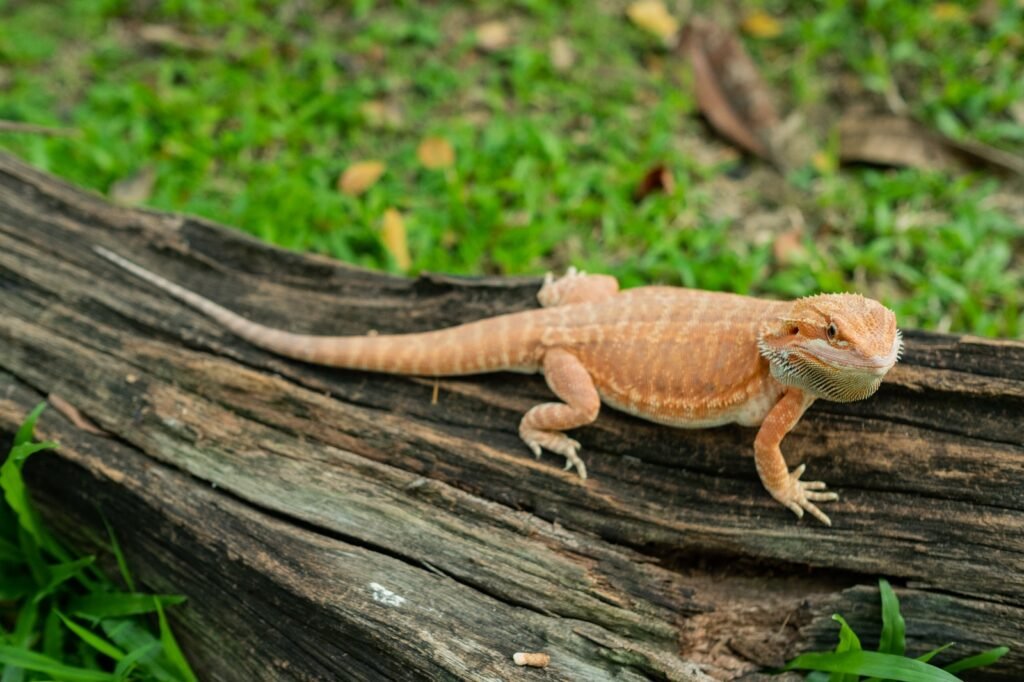
Just like humans, bearded dragons need regular exercise to stay healthy. Exercise keeps their muscles strong, aids digestion, and helps to keep their minds sharp and engaged. Without enough physical activity, these critters can become sluggish, overweight, and more prone to health issues.
Exercise Needs and Activities
⏳Daily Dose of Adventure: Aim for at least 30 minutes to an hour of active time outside their tank each day. It could be exploring a safe room or basking in the sun (with supervision, of course).
Playtime Ideas:
- Chase the Prey: Simulate hunting with live insects. It’s not just dinner; it’s a sport for them.
- Explore New Grounds: Let them wander in a dragon-proof area. Watch for electrical cords, small objects, or anything they might climb on that could tip over.
Safe Ways to Encourage Movement and Exploration
👍Dragon-Proofing 101: Before letting your dragon roam free, make sure the room is safe. Block off nooks and crannies where they could get stuck, remove toxic plants or small items they might nibble on, and ensure other pets won’t stress them out.
👍Buddy System: Always supervise your bearded dragon during playtime. They’re curious and can quickly get into mischief or danger without a watchful eye.
Climbing Structures and Layout Variations for Physical Stimulation
- Climbing Gym: Set up branches, rocks, and hammocks in their tank for daily climbing fun. Make sure everything is secure to prevent tumbles.
- Furniture Fun: Outside the tank, provide safe objects to climb on like cat trees or dedicated reptile furniture. This not only helps them exercise but also satisfies their climbing instincts.
- Change is Good: Every now and then, switch up the layout of their enclosure or play area. A new setup can spark curiosity and encourage more active exploration.
Remember, each dragon is unique. Some may be more athletic than others, so tailor the activities to your pet’s abilities and interests. Regular exercise and physical challenges will go a long way in ensuring your bearded dragon leads a long, healthy, and happy life. Keep it safe, keep it fun, and your scaly friend will thank you for it!
Mental and Sensory Enrichment for Bearded Dragons
Keeping your bearded dragon’s mind and senses engaged is just as crucial as physical exercise. Here’s how you can cater to their mental and sensory needs.
Music and Auditory Stimuli
❗Why It Matters: Bearded dragons can hear and respond to a range of sounds. Playing music or natural sounds can create a calming environment and stimulate their auditory senses.
How to Do It:
- Soft Tunes: Play gentle, soothing music to see if your dragon finds it relaxing.
- Nature Sounds: Simulate the wild with recordings of natural sounds like running water or forest noises.
- Volume Control: Keep the volume low to avoid startling or stressing your dragon.
Visual Stimulation through Colors and Movement
Bright and Beautiful
- Vivid Decor: Incorporate brightly colored items in the terrarium to attract your dragon’s attention.
- Changing Scenery: Regularly rearrange the terrarium setup to provide new sights.
Moving Marvels
- Dynamic Toys: Introduce toys that move, like a rolling ball, to catch their eye.
- Outside Views: Position the terrarium where your dragon can see outside, if safe and stress-free.
Smell and Taste Enrichment with Varied Diets and Scents
A Feast for the Senses
- Diverse Diet: Offer a wide range of fruits, vegetables, and insects to stimulate their taste buds and provide nutritional benefits.
- Herb Gardens: Small, safe, non-toxic plants inside the terrarium can offer new smells and tastes.
- Scent Trails: Create scent trails with safe, edible items to encourage exploration.
Spicing It Up
- New Foods: Introduce new foods gradually to see what they enjoy.
- Mealtime Variety: Change up the presentation of their meals to keep feeding times interesting.
Remember, every dragon is unique, so what excites one may not interest another. Pay close attention to how your bearded dragon responds to different stimuli and adjust accordingly to keep their environment enriching and stimulating.
Interactive Play and Handling for Bearded Dragons
Interacting with your bearded dragon is not just fun; it’s an essential part of their care that strengthens your bond and enriches their life. Here’s how to ensure these interactions are safe and enjoyable for both of you.
Tips for Safe and Enjoyable Handling
✔️Start Slow: If your dragon is new or not used to being handled, start with short sessions. Gradually increase the time as they become more comfortable.
✔️Support Their Body: Always support both the body and the tail when picking up your dragon. This makes them feel secure and prevents injury.
✔️Stay Close to the Ground: Keep handling sessions close to the ground or over a soft surface to minimize the risk of injury if they leap or fall.
✔️Read Their Mood: Pay attention to your dragon’s body language. If they seem stressed or scared, give them a break and try again later.
Recommended Toys and Games
- Feeder Ball: A feeder ball is a great way to turn mealtime into playtime. Fill it with live insects, and watch your dragon chase and bat it around.
- Laser Pointer: Bearded dragons can find a laser pointer’s light intriguing. Just be sure to never shine it directly into their eyes and to reward them with a tangible treat afterward to avoid frustration.
- DIY Obstacle Course: Create a simple obstacle course using safe household items. Encourage your dragon to navigate through for exercise and mental stimulation.
Building Trust Through Regular, Gentle Interaction
Consistency Is Key: Regular, gentle handling helps your dragon get used to you and build trust. Aim for daily interaction if possible.
Talk to Them: Speaking to your dragon in a calm, gentle voice can help them become accustomed to your presence and voice.
Reward with Treats: Offering a favorite treat during or after handling can create positive associations with being held.
Respect Their Space: Always observe your bearded dragon’s reactions. If they seem uncomfortable or stressed, respect their need for space and try again later.
Handling and interactive play are not just about keeping your bearded dragon physically active; they’re about creating a bond and understanding between you. With patience, consistency, and respect for their needs and boundaries, you can build a lasting friendship with your scaly companion.
Feeding as Enrichment for Bearded Dragons
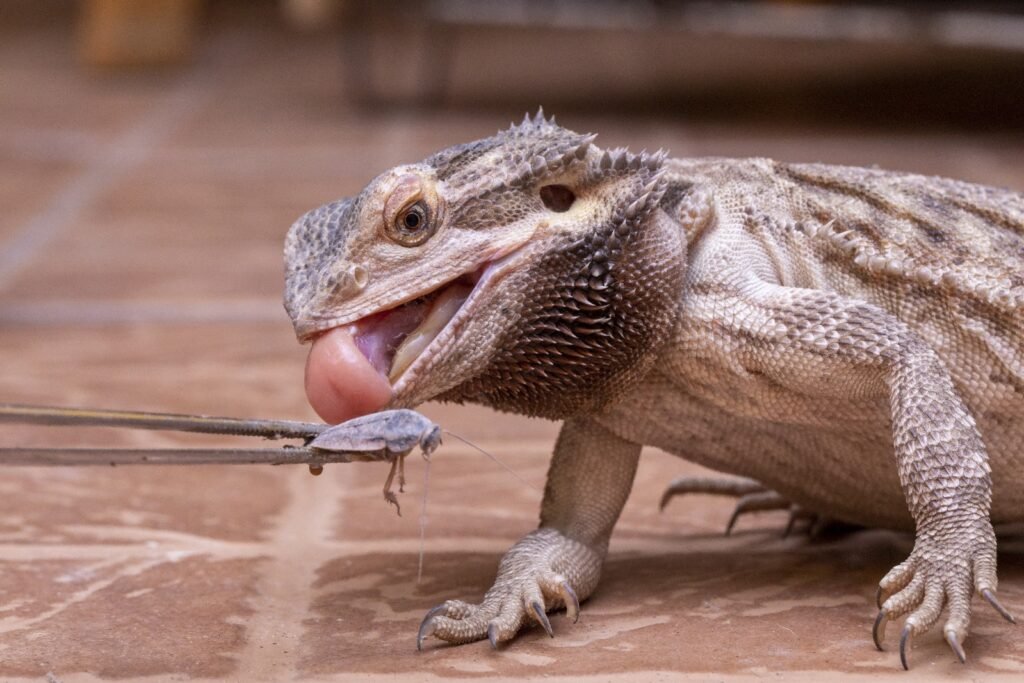
Creating an engaging and stimulating feeding experience for bearded dragons goes beyond mere nutrition. It involves enriching their environment and daily routines, encouraging natural behaviors, and enhancing their overall well-being. Here’s how you can turn feeding time into an enriching activity.
Live Prey and Hunting Behavior
🦗The Thrill of the Chase: Bearded dragons are natural predators. Allowing them to hunt live prey such as crickets, mealworms, or dubia roaches not only stimulates their hunting instincts but also provides physical exercise.
Safe Hunting Practices:
- Ensure the prey is appropriate for your bearded dragon’s size to prevent choking.
- Offer live prey in a controlled environment where you can monitor the interaction.
- Remove uneaten prey to avoid stress or injury to your dragon.
Benefits of Live Feeding:
- Encourages natural hunting and foraging behaviors.
- Provides mental stimulation and keeps your dragon engaged.
- Enhances coordination and physical health through the act of chasing.
Food Puzzles and Foraging Activities
Engage Their Minds: Food puzzles and foraging activities can significantly enhance your bearded dragon’s feeding time. These activities encourage problem-solving skills and mimic the challenge of finding food in the wild.
Simple Puzzle Ideas:
- Hiding food under small rocks or in hollow logs for them to discover.
- Using feeder balls that release insects as they are manipulated.
- Creating obstacle courses that lead to their food.
Foraging Fun:
- Scatter their favorite veggies around the terrarium to encourage exploration.
- Place food at different heights to promote climbing.
- Introduce a variety of textures and temperatures to spark curiosity.
Variety in Diet for Mental Stimulation
Mix It Up: A varied diet is crucial not only for nutritional balance but also for mental stimulation. Offering a range of foods can prevent boredom and encourage a more active interest in feeding times.
How to Offer Variety:
- Rotate between different types of greens, vegetables, and fruits.
- Introduce new foods gradually to gauge interest and tolerance.
- Present food in various ways—chopped, whole, or hidden—to keep things interesting.
Benefits of a Diverse Diet:
- Ensures a balanced intake of nutrients.
- Keeps feeding time exciting and unpredictable.
- Encourages a broader range of natural feeding behaviors.
By incorporating these enrichment strategies into your bearded dragon’s feeding routine, you not only cater to their nutritional needs but also to their instinctual behaviors, mental health, and overall happiness. Remember, the goal is to create a stimulating and enriching environment that mimics the natural world as closely as possible, encouraging your bearded dragon to explore, hunt, and forage as they would in the wild.
Health and Enrichment for Bearded Dragons
Creating a rich and varied environment for bearded dragons is essential not just for their physical well-being but for their overall health. Let’s explore how enrichment activities can benefit these pets, identify signs of possible stress due to overstimulation, and find a balance between activity and rest.
How Enrichment Contributes to Overall Health
🔸Physical Health: Activities like climbing, exploring, and hunting stimulate physical movement, which is crucial for maintaining a healthy weight and preventing obesity-related issues.
🔸Mental Health: Mental stimulation through interactive play, puzzle-solving, and exploring new environments can prevent boredom and depression, promoting a more active and engaged lifestyle.
🔸Stress Reduction: A well-enriched habitat can significantly reduce stress levels by providing a more natural and engaging environment, leading to a happier, healthier life.
🔸Recognizing and Addressing the Signs of Enrichment-related Stress or Overstimulation
Even good things can become too much. It’s important to recognize when your bearded dragon might be feeling overwhelmed:
Signs of Stress
- Hiding More Often: If your dragon is spending more time than usual in its hide, it might be trying to escape from something in its environment.
- Changes in Eating Habits: A sudden loss of appetite could indicate stress.
- Aggressive Behavior: More hissing, puffing up, or other aggressive actions can be signs of discomfort.
Addressing Overstimulation
- Reduce Complexity: Sometimes, simplifying the environment can help. Consider removing some of the enrichment items temporarily.
- Offer a Safe Hideaway: Ensure there are plenty of places where your dragon can retreat and feel secure.
- Monitor and Adjust: Keep an eye on how your dragon reacts to changes and adjust accordingly.
Balancing Enrichment with Rest and Routine
- Routine is Key: Stick to a regular schedule for feeding, playtime, and lights on/off to provide stability.
- Offer Downtime: Just like humans, bearded dragons need their downtime. Make sure they have ample opportunity for rest.
- Vary Activities: Rotate toys, change up the feeding schedule, and alter the habitat layout periodically to keep things fresh without becoming overwhelming.
Rest and Recovery
- Importance of Sleep: Ensure your dragon has a dark, quiet place to sleep undisturbed.
- Respect the Signs: If your dragon seems disinterested or stressed by an activity, it’s okay to take a break and try something else later.
As you can see, enrichment is a powerful tool for improving the health and happiness of bearded dragons. By offering a variety of stimulating activities while also paying attention to signs of stress and ensuring periods of rest, you can create a nurturing environment that supports both physical and mental well-being. Remember, each dragon is unique, so what works for one may not work for another. Observing your pet’s behavior and preferences will guide you in creating the most supportive and enriching habitat.
Enrichment Outside the Terrarium
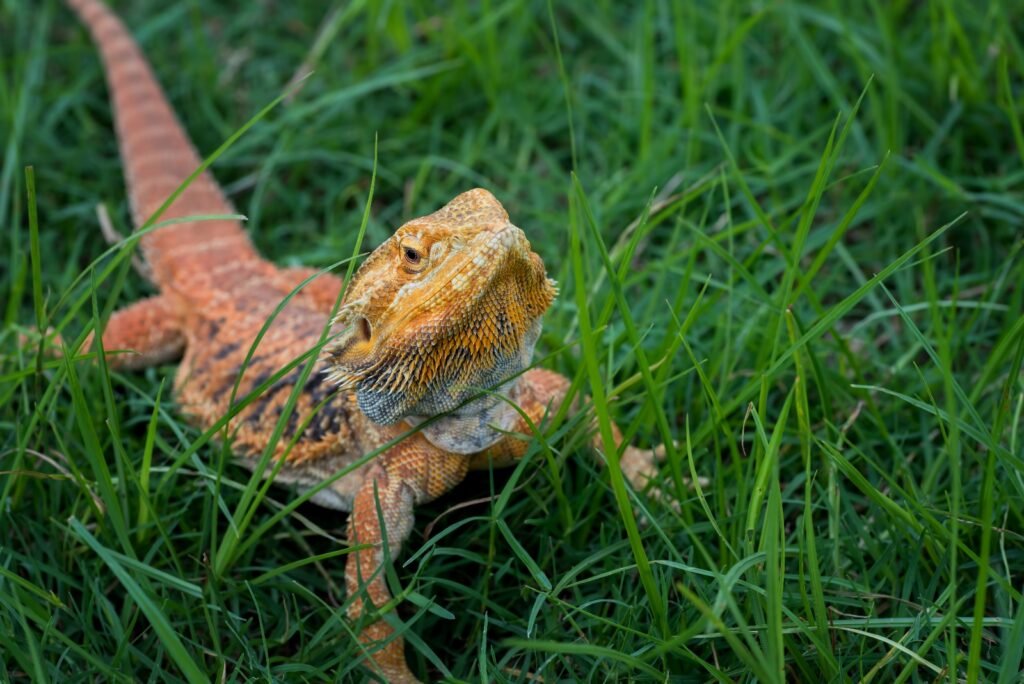
When it comes to providing enrichment for your bearded dragon, the world outside the terrarium offers a whole new realm of opportunities. Here’s how you can safely and effectively enrich your dragon’s life beyond the confines of their tank.
Supervised Exploration in Safe, Dragon-Proofed Areas
Exploring the Great Outdoors: Bearded dragons are naturally curious creatures, and supervised exploration in safe, dragon-proofed areas can provide them with a stimulating experience.
Choosing the Right Environment:
- Opt for secure outdoor spaces such as fenced-in yards or enclosed gardens to prevent escapes.
- Remove any potential hazards such as toxic plants, sharp objects, or other animals that may pose a threat to your dragon.
Supervision is Key:
- Always supervise your bearded dragon during outdoor excursions to ensure their safety.
- Keep a close eye on them to prevent accidents and intervene if necessary.
Benefits and Precautions of Outdoor Time
Benefits
- Natural Sunlight: Exposure to natural sunlight provides essential UVB rays necessary for vitamin D synthesis, which promotes healthy bone growth.
- Mental Stimulation: Outdoor environments offer new sights, sounds, and smells that can stimulate your dragon’s senses and prevent boredom.
Precautions
- Weather Considerations: Avoid taking your dragon outside during extreme weather conditions such as high temperatures or heavy rain.
- Predator Protection: Keep an eye out for potential predators such as birds of prey or other animals that may pose a threat to your dragon.
Swimming and Bathing for Physical and Mental Health
The Joy of Swimming:
- Bearded dragons are not natural swimmers, but some may enjoy supervised swimming sessions in shallow water.
- Ensure the water is shallow enough for your dragon to stand comfortably and always be present to monitor their safety.
Bathing for Health and Hygiene:
- Regular baths can help keep your dragon’s skin hydrated and aid in shedding.
- Use lukewarm water and a soft brush to gently clean any debris or shed skin from their scales.
Mental Health Benefits:
- Swimming and bathing can provide mental stimulation and relaxation for your dragon, promoting overall well-being.
Incorporating supervised outdoor exploration, swimming, and bathing into your bearded dragon’s routine can provide valuable enrichment opportunities and contribute to their physical and mental health. Just be sure to take necessary precautions and always prioritize your dragon’s safety and well-being.
Creating a Routine for Enrichment
Establishing a consistent routine for enrichment activities is essential for ensuring your bearded dragon’s mental and physical well-being. Here’s how you can structure a routine that meets your dragon’s needs while incorporating variety and flexibility.
Structuring Daily Enrichment Activities
🔸Morning Routine:
- Begin the day with a brief period of supervised exploration outside the terrarium to soak up natural sunlight and stimulate their senses.
- Offer a variety of live prey or food puzzles to encourage hunting and foraging behaviors during the morning feeding.
🔸Midday Interactions:
- Provide interactive toys or climbing structures within the terrarium for midday play sessions.
- Rotate toys and rearrange the terrarium layout periodically to maintain interest and prevent boredom.
🔸Evening Relaxation:
- Wind down in the evening with a gentle brushing or bathing session to promote relaxation and assist with shedding.
- Offer a final opportunity for exploration or play before settling in for the night.
The Role of Consistency and Change in Enrichment Practices
✔️Consistency is Key:
- Stick to a regular daily schedule for feeding, handling, and enrichment activities to provide structure and predictability for your dragon.
- Consistent routines can help reduce stress and promote a sense of security for your pet.
✔️Embrace Variety:
- Introduce new enrichment activities or toys regularly to keep things fresh and exciting.
- Experiment with different types of enrichment, such as sensory stimulation, physical exercise, and problem-solving challenges.
✔️Observe and Adapt:
- Pay close attention to your dragon’s behavior and preferences during enrichment activities.
- Be flexible and willing to adapt your routine based on their reactions and feedback.
✔️Learn Their Likes and Dislikes:
- Observe how your dragon interacts with different enrichment items and activities.
- Take note of their preferences for certain toys, foods, or environmental features.
✔️Customize Enrichment:
- Tailor your enrichment routine to cater to your dragon’s individual preferences and personality.
- Offer a variety of options and allow your dragon to choose activities that interest them most.
✔️Stay Attuned:
- Continuously monitor your dragon’s response to enrichment activities and be prepared to make adjustments as needed.
- Remember that every dragon is unique, so what works for one may not work for another.
By structuring a routine that combines consistency with variety and flexibility, you can provide your bearded dragon with a stimulating and enriching environment that supports their physical and mental health. Pay attention to their preferences and adapt your approach accordingly to ensure a fulfilling and enjoyable experience for your pet.
Advanced Enrichment Strategies for Bearded Dragons
Taking enrichment to the next level involves implementing advanced strategies that stimulate your bearded dragon’s mind and body in new and exciting ways. Let’s explore how you can enhance your dragon’s environment and well-being with these advanced techniques.
Training and Learning Capabilities of Bearded Dragons
Understanding Their Potential:
- Bearded dragons are highly intelligent reptiles capable of learning and responding to training cues.
- With patience and positive reinforcement, you can teach your dragon to perform simple tricks and behaviors.
Training Techniques:
- Start with basic commands such as targeting or hand targeting.
- Use treats or favorite foods as rewards to reinforce desired behaviors.
- Keep training sessions short and consistent to maintain their interest and focus.
Implementing Advanced Toys and Tech for Enrichment
Tech-Savvy Solutions:
- Explore interactive toys and devices designed specifically for reptiles, such as motion-activated feeders or puzzle games.
- Incorporate environmental sensors or timers to simulate natural light and temperature changes within the terrarium.
DIY Enrichment Projects:
- Get creative and design your own enrichment toys and obstacles using safe materials such as PVC pipes, untreated wood, or natural rocks.
- Experiment with different textures, shapes, and sizes to keep your dragon engaged and challenged.
The Role of the Owner in Continuously Enhancing the Dragon’s Environment
Ongoing Engagement:
- As the owner, you play a crucial role in continuously enhancing your dragon’s environment and enrichment opportunities.
- Stay informed about new advancements in reptile care and enrichment techniques to keep your dragon’s environment dynamic and stimulating.
Observation and Adaptation:
- Regularly observe your dragon’s behavior and interactions with enrichment items to identify areas for improvement.
- Be open to feedback and adjust your enrichment strategies based on your dragon’s preferences and responses.
Bonding and Interaction:
- Use enrichment activities as an opportunity to bond with your dragon and strengthen your relationship.
- Engage in interactive play and training sessions to build trust and rapport over time.
By incorporating advanced training techniques, innovative toys and technology, and ongoing owner involvement, you can create an enriched environment that promotes your bearded dragon’s physical, mental, and emotional well-being. Stay proactive and engaged in continuously enhancing their environment to ensure a fulfilling and enriching life for your beloved pet.

